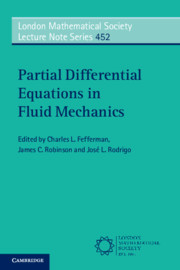Book contents
- Frontmatter
- Contents
- Contributors
- Preface
- 1 Remarks on recent advances concerning boundary effects and the vanishing viscosity limit of the Navier–Stokes equations
- 2 Time-periodic flow of a viscous liquid past a body
- 3 The Rayleigh–Taylor instability in buoyancy-driven variable density turbulence
- 4 On localization and quantitative uniqueness for elliptic partial differential equations
- 5 Quasi-invariance for the Navier–Stokes equations
- 6 Leray’s fundamental work on the Navier–Stokes equations: a modern review of “Sur le mouvement d’un liquide visqueux emplissant l’espace”
- 7 Stable mild Navier–Stokes solutions by iteration of linear singular Volterra integral equations
- 8 Energy conservation in the 3D Euler equations on T2 × R+
- 9 Regularity of Navier–Stokes flows with bounds for the velocity gradient along streamlines and an effective pressure
- 10 A direct approach to Gevrey regularity on the half-space
- 11 Weak-Strong Uniqueness in Fluid Dynamics
6 - Leray’s fundamental work on the Navier–Stokes equations: a modern review of “Sur le mouvement d’un liquide visqueux emplissant l’espace”
Published online by Cambridge University Press: 15 August 2019
- Frontmatter
- Contents
- Contributors
- Preface
- 1 Remarks on recent advances concerning boundary effects and the vanishing viscosity limit of the Navier–Stokes equations
- 2 Time-periodic flow of a viscous liquid past a body
- 3 The Rayleigh–Taylor instability in buoyancy-driven variable density turbulence
- 4 On localization and quantitative uniqueness for elliptic partial differential equations
- 5 Quasi-invariance for the Navier–Stokes equations
- 6 Leray’s fundamental work on the Navier–Stokes equations: a modern review of “Sur le mouvement d’un liquide visqueux emplissant l’espace”
- 7 Stable mild Navier–Stokes solutions by iteration of linear singular Volterra integral equations
- 8 Energy conservation in the 3D Euler equations on T2 × R+
- 9 Regularity of Navier–Stokes flows with bounds for the velocity gradient along streamlines and an effective pressure
- 10 A direct approach to Gevrey regularity on the half-space
- 11 Weak-Strong Uniqueness in Fluid Dynamics
Summary
This article offers a modern perspective that exposes the many contributions of Leray in his celebrated work on the three-dimensional incompressible Navier-Stokes equations from 1934. Although the importance of his work is widely acknowledged, the precise contents of his paper are perhaps less well known. The purpose of this article is to fill this gap. We follow Leray's results in detail: we prove local existence of strong solutions starting from divergence-free initial data that is either smooth or belongs to $$H^1$$ or $$L^2 \cap L^p$$ (with $$p \in (3,\infty]$$), as well as lower bounds on the norms $$\| \nabla u (t) \|_2$$ and $$\| u(t) \|_p$$ ($$p\in(3,\infty]$$)as t approaches a putative blow-up time. We show global existence of a weak solution and weak-strong uniqueness. We present Leray's characterisation of the set of singular times for the weak solution, from which we deduce that its upper box-counting dimension is at most 1/2. Throughout the text we provide additional details and clarifications for the modern reader and we expand on all ideas left implicit in the original work, some of which we have not found in the literature. We use some modern mathematical tools to bypass some technical details in Leray's work, and thus expose the elegance of his approach.
Keywords
- Type
- Chapter
- Information
- Partial Differential Equations in Fluid Mechanics , pp. 113 - 203Publisher: Cambridge University PressPrint publication year: 2018
- 5
- Cited by

